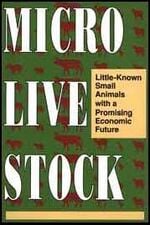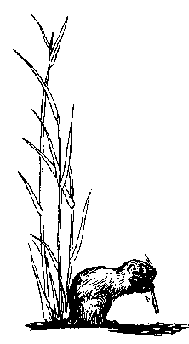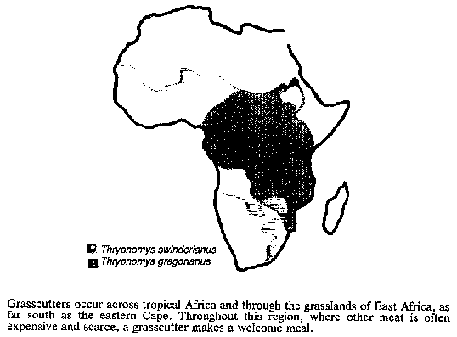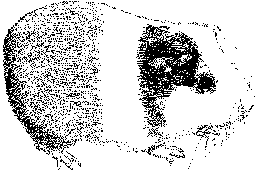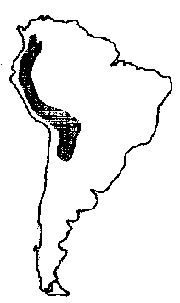19 Grasscutter[edit | edit source]
The grasscutter (Thryonomys swinderianus and Thryonomys gregorianus) is found in many forests and savannas of Africa. Its meat, said to resemble suckling pig, often sells for more per kilogram than chicken, beef, pork, or lamb. It is the preferred, and perhaps most expensive meat in West Africa. Indeed. in Ivory
Coast it sells for about $9 per kg. With prices like that, grasscutter is a culinary luxury that only the wealthy can afford.
If domestication of this wild species were successful in providing meat at a price similar to that of poultry (the second most popular meat), markets would be unlimited.2 However, as production costs are high, long-term research will be required before grasscutter production can be profitable to the small farmer. This research should now be undertaken.
In an effort to capitalize on the markets for this delicacy, agricultural extension services of Cameroon, Ghana, Ivory Coast, Nigeria, Togo, and particularly Benin are already encouraging farmers to rear grasscutters as backyard livestock. They furnish breeding stock and information, and maintain central offices for records. In addition, a bilateral cooperation project in Benin has started experimental work on improved breeding methods combined with the study of animal responses under domestication.3
In future, this vegetarian animal might become the African equivalent of South America's guinea pig, playing an important role in reducing Africa's chronic protein shortage.
AREA OF POTENTIAL USE
Humid and subhumid Africa south of the Sahara.
APPEARANCE AND SIZE
Grasscutters are robust animals with short tails, small ears, and stocky bodies. Taxonomically, they are more closely related to porcupines than to common rats or mice.
Although many varieties have been described, there are probably only two species. The larger (Thryonomys swinderianus) weighs 9 kg or more and has a head-and-body length of up to 60 cm. The smaller species (Thryonomys gregorianus) may occasionally reach 8 kg and a body length of 50 cm.
Both species have yellow-brown to gray-brown bodies, with whitish bellies. The fur is extremely coarse, firm, and bristly - reflecting the animal's kinship to the porcupine. The tail is scaly and has short, sparse hairs.
Both species have thick, heavy claws and enormous orange incisors that can chew through even the toughest vegetation. (Grasscutters have been known to tear holes in corrugated iron fences.) Nevertheless, they do not bite when handled, although their claws sometimes cause injuries.4
DISTRIBUTION
Grasscutters occur in grassland or in wooded savanna throughout the humid and subhumid areas of Africa south of the Sahara. They often live in forest-savanna habitats where grass is present. They do not inhabit rainforest, dry scrub, or desert, but they have colonized the road borders in forest regions. Distribution is determined by availability of adequate or preferred grass species for food. Specifically, Thryonomys swinderianus occurs in virtually all countries of west, east, and southern Africa. Thryonomys gregorianus occurs in savannas in Cameroon, Central African Republic, Zaire, Sudan, Ethiopia, Kenya, Uganda, Tanzania, Malawi, Zambia, Zimbabwe, and Mozambique.
STATUS
Despite heavy hunting, these animals are not threatened with extinction. Nonetheless, many individual populations are well below carrying capacity, or are extinct because of local overexploitation.
HABITAT AND ENVIRONMENT
The larger grasscutter (T. swinderianus) generally lives in swampy, low-lying areas, especially along river banks and the borders of lakes and streams. Occasionally, it is found on higher ground among bushes and rocks, living where savanna grasses are dense and tangled enough to afford good cover. In Ivory Coast and southern Guinea, for instance, grasscutters are found (and hunted) throughout the savanna zones. And they can occur in close proximity to farmlands and people (for example, in southwest Nigeria).
BIOLOGY
Although the precise diet in the wild has not been determined, grasscutters are vegetarian. They consume nuts, bark, and the soft parts of grasses and shrubs. They particularly favor elephant grass and sweet potatoes. They commonly "raid" cassava and yam plantations, and are considered local pests.
Grasscutters reproduce year-round, although the births seem to peak at certain times of the year, correlated with weather conditions.5 Probably one male takes several females, and the family group possibly has more than one generation of young. The gestation is about 152 days. Apparently, litters normally contain between 2 and 4 young, but in Benin and Togo some litters of up to 11 or 12 are reported.6 Newborns are fully developed, their eyes are open, they weigh approximately 80 g, have thick fur, and quickly become accomplished runners.
BEHAVIOR
Although they commonly forage in groups, grasscutters are generally solitary. They are nocturnal, and they travel at night through trails in reeds and grass, often to water. Most specimens seen in markets are males, possibly because males lead the groups and are thus most prone to being trapped.
When alarmed, these animals stamp their hind feet and give a strange booming grunt. When fleeing, they can run very fast and, given a chance, will take to water. They swim with ease.
For shelter, grasscutters usually weave nests of matted vegetation or scoop out shallow burrows.
USES
In a broad geographic band across sub-Saharan Africa, cattle raising is severely limited by trypanosomiasis. There, other sources of animal protein, including rodents, are traditionally used. Thus, grasscutter meat constitutes an important food for many Africans. The animals are mostly caught and eaten by families for their own use, but some are sold in markets and especially in roadside stalls. Many families depend exclusively on selling bushmeat, particularly that of grasscutters. In Accra, Ghana, during one year, 73 tons of grasscutter meat were sold in the local market. This represented more than 15,000 animals. In southern Africa, too, people find that these rodents make tasty food, although they may cut off the tail to make the carcass look less ratlike.
The meat is usually eaten smoked, and is so much in demand that grasscutters are hunted in organized drives with spears, dogs, and sometimes fire. It is considered excellent, especially when cooked in soups and stews or barbecued.7 It has been described as resembling venison in flavor, but it is dark like the meat of wild duck.
HUSBANDRY
In the savanna area of West Africa, people have traditionally captured wild grasscutters and raised them at home. As an extension of this, organized grasscutter husbandry has been initiated in West Africa. The animals are provided with marshy, tightly fenced areas with plenty of plant cover. The young are harvested from these areas and raised separately.
Ghanaian researcher Emanuel Asibey, a pioneer of this research, reports success at getting such captive stocks to reproduce. To this end, farmers are provided with breeding boxes and foundation grass cutter colonies. They are taught how to rear and feed the animals for home consumption or for cash income. Basically, the farmers make available large sheds where the animals can move freely. To prevent escape, the walls may be reinforced with cement plaster. The farmers also provide piles of grass, sugarcane, and other foods. A grasscutter reportedly takes about a month to adjust to such confinement. High mortality can occur in this period. The average weight of a mature, home-raised grasscutter is 4-7 kg. The average killing-out (dressed carcass) is 64 percent.8
The Wildlife Domestication Unit of Ibadan University in Nigeria, another pioneer of rodent domestication, has also reported the potential of domesticated grasscutter colonies.9
Research on grasscutter breeding, husbandry, and feeding is similarly being implemented by the Ministry for Rural Development in Benin and at the Lacena in Ivory Coast (see Research Contacts).
ADVANTAGES
The demand for grasscutter meat is so large that it is not being met. Markets for it already exist over much of Africa,
LIMITATIONS
Grasscutters can devastate such crops as rice, sugarcane, soybeans, peanuts, yams, cassava, sweet potatoes, oil-palm seedlings, maize, young rubber, sorghum, and wheat. Therefore, as with most rodents, they should be reared only in areas where they already exist.
In past years, captive animals in Benin have suffered fatal Clostridium infections during September and October. In 1986, a broad-spectrum antibiotic was given with outstanding results. During this season, the animals also suffered from ascarid worms, which were also successfully treated with standard drugs.10
RESEARCH AND CONSERVATION NEEDS
Research is needed in the following areas:
- Digestive physiology, feeding habits, feed preferences, feed conversion and growth rate;
- Diseases (pathogens and parasites);
- Captive breeding and management (growth rates, space requirements, feed needs, etc);
- Performance under different environments;
- Productivity; and
- Basic biology (for example, chromosome type, reproductive physiology, and social behavior both in its wild state and under controlled conditions).
Moreover, specimens should be gathered from different regions for comparative evaluation. A particular need is to select and breed docile specimens because today, even after several generations in captivity, the animal must still be handled with caution.
Although domestication of the grasscutter is encouraged, wild populations might also be managed to maximize and sustain production through habitat manipulation.
20 Guinea Pig[edit | edit source]
Guinea pigs (Cavia porcellus) are promising microlivestock because they require little capital or labor; provide an inexpensive, readily available, palatable meat; have no odor, and are suitable for keeping indoors. In the highlands of the Andes, many Indians raise them to supplement diets based on grains and vegetables. Families eat them mostly on special occasions such as weddings and first communions, or they sell them to restaurants or peddle them in village markets.
The low cost of these small animals makes them available even to many landless peasants. For both the small farmer and apartment dweller, the guinea pig is a possible food reserve. It converts kitchen scraps and marginal wastelands into meat. According to estimates, 20 females and 2 males may produce enough meat year-round to provide an adequate meat diet for a family of 6.2
Since husbandry practices are simple and cheap, the guinea pig is an excellent source of supplementary income. An FAO study at Ibarra, Ecuador, showed that on small mountain farms the guinea pig provided more profit than either pigs or dairy cows, partly because its meat fetched high prices.
Although domesticated guinea pigs are mainly a food resource of Latin America, their use has also spread to parts of Africa and Asia. They are raised, for instance, in Nigeria, Cameroon, Ghana, Sierra Leone, Togo, and Zaire. In southern Nigeria, at least 10 percent of all households raise guinea pigs for food, with colonies of up to 30 animals per household. Guinea pigs are also raised in small cages or cardboard boxes by small farmers in the Philippines.3
The feeding efficiency is high: studies have shown that it takes between 3.2 and 5.7 kg of forage to produce 1 kg of growth. This makes guinea pigs more efficient than most farm mammals.
Guinea pigs seem especially adapted to the climate and forages of high-altitude zones, but the fact that they are being raised in Central and West Africa indicates that they are also adapted to the lowland tropics.
AREA OF POTENTIAL USE
Worldwide.
APPEARANCE AND SIZE
Guinea pigs have stocky bodies, fairly short hind legs, and short, unfurred ears. Adults can weigh up to 2 kg, but an average-sized specimen is about 0.5 kg. They are 20-40 cm long (average 28 cm) and have no tail. In domesticated forms, the pelage may be smooth or coarse, short or long, and in some types the hairs form rosettes.4 Domesticated types come in colors ranging from white to dark brown, as well as piebald.5
DISTRIBUTION
The original home of the wild guinea pig is believed to have been the central highlands of Peru and Bolivia. Its domesticated descendants are important as meat animals mainly in that same area, but, as noted, they are also important in certain African and Asian countries.
A few strains are distributed worldwide as laboratory animals and pets.
STATUS
Domesticated guinea pigs, as a whole, are in no danger of extinction, although some rare strains are threatened.
HABITAT AND ENVIRONMENT
These extremely adaptable animals are found in temperate zones and in the highland tropics, but they are usually kept indoors and protected from the extremes of weather. In Lambayeque and other departments of Peru, they are reared at elevations from sea level to more than 4,000 m. In areas where they are raised, daily temperatures fluctuate as much as 30°C. In the Bolivian or Peruvian puna region, for instance, day temperatures can be 22°C, while night temperatures are -7°C. However, they cannot survive freezing temperatures and they may not perform well when exposed to the full tropical heat and sunlight. Many people of the Peruvian highlands keep the animals in darkness (for example, in wood boxes with little or no light).6
The animal's original wild habitat is believed to have been an area of grasslands, forest edges, swamps, and rocks.
BIOLOGY
These herbivores can be raised on kitchen scraps, garden wastes, and weedy vegetation plucked from backyards or roadsides. Andean peasants mainly feed them potato peels, scraps of cabbage, lettuce, carrot, wild grasses, corn stalks, and the foliage of miscellaneous wild plants. Some barley and alfalfa is grown specifically for guinea pigs; it is cut green and sold in small bundles in the markets.
Guinea pigs mate throughout the year except when climate is excessively adverse. Domestic breeds average 2-3 young per litter, although larger litters sometimes occur. The gestation period is 65-70 days with an average of 67. Females come into estrus every 13-24 days, and there is a fertile postpartum estrus.
Females can become pregnant when merely 3 months old, and many produce 4 litters every year from then on. In principle, a farmer starting with 1 male and 10 females could see his herd grow to 3,000 animals in one year.
Newborns are so large that the female's pubic bones must separate for the birth. They emerge fully developed, with fur and open eyes. They look like miniature adults, and they start eating grass and other feedstuffs within hours. (For this reason, babies orphaned at birth have been known to survive.) Weaning may be reached as early as 21 days of age.
The life span in captivity is as long as 8 years, but animals used for breeding usually live only 3.5 years.
SUPER GUINEA PIGS
Even in their native region, guinea pigs have traditionally received little research attention. However, that began changing in the 1970s with the onset of meat shortages in Peru. (For a time the government restricted beef sales to only 15 days a month.)
For instance, in 1972 Peru began a guinea pig improvement project. Researchers from i a Molina National Agrarian University traveled throughout Peru gathering many kinds of guinea pigs short haired long haired black, white, yellow, brown, and even purple. Practically all the guinea pigs eaten in Peru are home grown, and researchers observed that the bigger ones were generally winding up in the stew, leaving the smaller ones for breeding. The people inadvertently were making the animals smaller. (This is a common phenomenon for many animals.)
To overcome it, the university research workers compared the mature size and growth rates of all the different guinea pigs. They selected and cross-bred the biggest, meatiest, and fastest-growing ones. This program, later taken over by Instituto Nacional de Investigacion y Promocion Agropecuaria (INIPA), produced remarkable results. The starting animals averaged little more than 0.5 kg, the resulting ones averaged almost 2 kg.
Peru's "super guinea pigs" are now getting international recognition. They have been introduced into the highlands of Honduras, where the animal is also part of the Indian cuisine. The FAO has shipped some to the Dominican Republic. In addition, Bolivia, Ecuador, and Colombia have all begun their own guinea pig improvement programs.
Within Peru the government has established 11 breeding stations to encourage the farming of guinea pigs for food. The goal is to provide better stud males to the people so that future animals will grow more quickly and reach a greater weight.
BEHAVIOR
Guinea pigs generally congregate in small groups, normally made up of 5-10 adults. In favorable areas, however, such groups may coalesce into large colonies. The animals communicate incessantly among themselves, emitting a variety of squeaks and other noises.
Males, although good-natured with other species, often fight fiercely among themselves.
USES
Guinea pigs are raised mainly for meat. Peru has about 20 million, which annually provide 16-17,000 tons of meat (only 4,000 tons less than Peru's sheep meat production).
Guinea pigs are used worldwide for studies on disease, nutrition, heredity, and toxicology, as well as for the development of serums and other biomedical research.
HUSBANDRY
Guinea pigs require so little space that a small cage or pit can house up to 10 females and 1 male. They can be raised in cages with wire floors of small mesh as well. The labor required is low. A colony of 1,000 females reportedly can be properly cared for by one person. A layer of wood shavings, shredded paper, straw, and dried corncobs is usually recommended for bedding. The droppings are odorless, so the bedding does not need changing as often as with other animals. When the diet mainly consists of greens, much urine is produced, and then the beds have to be changed frequently.
When grown for meat, the young are weaned at 3-4 weeks and are ready for market in a matter of 10-13 weeks. Weight gain is rapid for the first 4-6 weeks, and then decreases. The carcasses normally dress out at about 65 percent, including the skin and legs. The meat's protein content is approximately 21 percent.7
In a few regions of Peru, guinea pigs are "herded" on the open range and retired at night into small adobe coops.
ADVANTAGES
This small, inoffensive animal rarely bites, is easy to manage, and has no smell. It is an excellent supplemental meat supply. The improved breeds cannot climb or jump so that they are easy to contain. (Primitive "criollo" types, however, can jump.) If kept dry and given green vegetation, grain, and water, it survives in many environments.
LIMITATIONS
A major constraint is consumer reluctance. Even in Latin America, attempts to promote guinea pig consumption outside the Indian communities have failed.
When raised in a clean environment and under normal feeding conditions, guinea pigs thrive and reproduce and do not need routine vaccinations or antibiotics that cattle, sheep, and pigs often require. However, guinea pigs can be carriers of Chagas' disease and salmonella. Further, they are susceptible to pneumonia if temperatures change abruptly when conditions are wet. Coccidiosis and internal and external parasites are also common.
Green forages and surplus fruits or by-products are critical to provide vitamin C, which the animal is unable to synthesize for itself.
RESEARCH AND CONSERVATION NEEDS
Since the greatest concentration of guinea pigs is found in the Andes, particular efforts should be directed towards this region. Already, research on guinea pigs has begun in some universities and government research stations in Colombia, Ecuador, Venezuela, Peru, and Bolivia, but more work is needed on matters such as:
- Breeding "elite" stock for distribution;
- Feeding and nutritional-requirement trials, especially for creating alternate feeds that peasants and commercial producers can use during seasons when conventional feeds are hard to get;
- Diseases and parasites that may limit production in small farming systems;
- Management practices concerning reproduction, housing, herd size, and feeding; and
- The genetic basis for weight gain and productivity.
Some research should be directed towards developing rations or introducing drought-resistant forages for the dry season because green forage is needed year-round. A range of practical and economical diets needs to be created.
Animal geneticists in Latin American countries should establish "elite" populations that can provide superior stock throughout the world. It can be anticipated that applying modern breeding methods to existing improved strains will result in great advances in a relatively short period and at little cost (see sidebar).
Three species of wild cavies (Cavia aperea, C. fulgida, and C. tschudii), close relatives of the guinea pig, are native to South America and are declining drastically. Research to preserve them is urgently needed. C. aperea is a widely used item of food in rural Brazil and other parts of South America.
21 Hutia[edit | edit source]
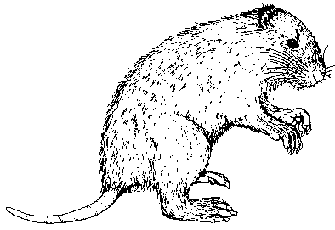
The first meat Christopher Columbus tasted in the New World was probably hutia, a rodent avidly hunted by the Carib Indians. Hutia bones have been unearthed from kitchen middens of pre-Columbian inhabitants of all the Greater Antilles. Indians carried live hutias on voyages possibly in a semidomestic state as a source of food. On some islands, hutias were so eagerly sought that their populations were destroyed long before Europeans arrived. Slaves in the cane fields also hunted hutias for food. The surviving species later suffered when forests were cleared and cats, dogs, mongooses, and other predators were introduced. Consequently, the majority of hutia species died out, and today most surviving members of the family (Capromyidae) are facing extinction. Human predation continues in some areas (for instance, in Jamaica) where the tradition of "coneyhunting" still endures in a few regions.
Hutias should be tested as possible microlivestock: success could create the incentive for their complete protection. The animals seem to take well to captivity. The Jamaican hutia is already overproducing in zoos, causing a local glut of animals. And hutias are, or were until recently, kept in barns by some people in Cuba, who fed them on banana and other vegetable waste and ate them regularly.'
POTENTIAL AREA OF USE
The Caribbean.
APPEARANCE AND SIZE
Hutias are broad-headed, short-legged, robust animals with small eyes and ears. The various species are from 20 to 60 cm long and weigh from 1 to 9 kg - a size range from that of a guinea pig to that of a small dog. They walk with a slow, waddling motion, but can hop quickly if frightened or pursued. They also climb well.
The 10 1iving species are all big enough to be candidates for microlivestock. The best known and easiest species to keep in captivity are the Cuban hutia (Capromys pilorides) and Jamaican hutia (Geocapromys brownii).
The Cuban hutia (also called hutia conga) is about 60 cm long, with coarse fur, a raccoon-shaped body, and a thick tail covered with sparse bristles. A forest dweller, it weighs up to 7 kg.
The short-tailed Jamaican hutia is smaller: it is 33-45 cm long and weighs up to 2.5 kg.
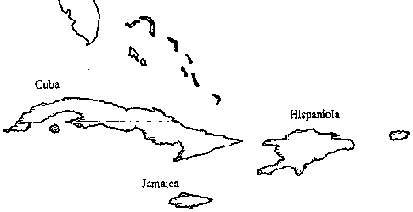
DISTRIBUTION
Hutias are found only in the Caribbean (Greater Antilles and Bahamas). Most species are confined to a single island, where they represent the only remaining indigenous land mammals. The Cuban hutia is found only in Cuba. The Jamaican hutia is found only in Jamaica, although a close relative occurs on East Plana Cay, Bahamas.
STATUS
This once widely distributed and plentiful family is now failing. Of the 30 or so known recent taxa, more than half are already extinct, and the remainder all suffer from habitat alteration, predation by introduced animals, and hunting by man. With the exception of the Cuban hutia, all species are included on the list of the world's threatened mammals.
HABITAT AND ENVIRONMENT
Hutia ranges have been so reduced that these animals survive only in the most inaccessible forests and rocky drylands. Both the Cuban and the Jamaican hutias occur in a variety of habitats from montane cloud forests to arid coastal semideserts.
BIOLOGY
Most species are terrestrial, but some live in trees. The Cuban and Jamaican species are terrestrial, but they can climb trees if circumstances demand. They maneuver well on trunks and larger branches, descending head first like squirrels.
Hutias are primarily vegetarian, their diets consisting of leaves, bark, fruits, and twigs, as well as incidental catches of small animals such as lizards and invertebrates.
Hutias seem to breed year-round, generally giving birth to litters of 1-4 offspring after a gestation period of 16-20 weeks. The young are well developed at birth, fully haired, open eyed, and capable of most adult movements. After 10 days they begin taking solid food, although they are not fully weaned for at least a month and a half (5 months for the Cuban hutia). Sexual maturity is at 10 months; life expectancy is 8-11 years in captivity.
The Jamaican hutia has one of the highest diploid chromosome numbers (2n = 88) of any mammal.
BEHAVIOR
Most hutias are wary and secretive and are easily displaced by human encroachment. They live like rabbits, hiding among tangled vegetation, in holes, and among rocks - communicating by voice and scent markings. They build shelters mainly in rock crevices, but also in the base of thick bushes or in natural cavities in trees. The Cuban hutia is often diurnal, whereas the Jamaican hutia is largely nocturnal.
HISPANIOLAN HUTIA
The Hispaniolan hutia, or zagouti (Plagiodontia aedium) as it is known in Haiti is smaller than the two Capromyids discussed here, weighing just 1.2 kg. It is difficult to breed in captivity and has a lower reproductive rate than either the Jamaican or Cuban hutia. It is therefore less suitable as an economic or food source.
However, there is a significant need for supplemental protein sources in both Haiti and the Dominican Republic. It might be possible to develop a special captive-breeding program for this animal, but it should be done with great care. It is important that a hunting tradition for this animal not be reestablished in rural areas of Haiti or the Dominican Republic, and that local organizations not be misled into believing that there will be a rapid increase in the numbers of this species in captivity.
USES
Hutia meat is relished, especially in Jamaica. The animals are still hunted, often by using dogs that smell them out and retrieve them from a hole or hold them at bay in treetops.
HUSBANDRY
Experiences of zoos suggest that the Cuban and Jamaican hutias will thrive in captivity. The animals are generally long-lived and have survived up to 17 years. They are often friendly with their keepers and, when tame, can be held and carried about without any particular danger. However, if angered they can inflict deep bites and should normally be handled with considerable caution.
ADVANTAGES
These animals are already much in demand. Their meat has an excellent flavor and they are big enough to provide a worthwhile quantity. If husbandry could be developed on a sustainable basis, it could be used as a mechanism for both economic development and for saving the remnant populations.
LIMITATIONS
Wild populations are threatened. Any captive population must be built up without endangering them.
All hutias are susceptible to predation by domestic cats, mongooses, dogs, and human poachers, so care must be taken to design predator-proof breeding facilities.
These animals are carriers of eastern equine encephalomyelitis, a serious disease of horses.
RESEARCH AND CONSERVATION NEEDS
Hutias deserve urgent conservation attention. In particular, the following steps should be taken:
- Establish reserves in natural habitats containing breeding populations to ensure the survival of the genetic diversity of these animals.
- Build up breeding populations in suitable zoos and livestock research centers.
- Gather specimens from different regions for comparative evaluation.
- Investigate hutia biology, including chromosome type, reproductive physiology, nutrition, and diseases.
- Assess experiences of zoos.
- Perform captive breeding trials, measuring growth rates, space requirements, food needs, and social behavior (both in its wild state and under controlled conditions).
- Study the social organization and tameability.
Colonies of some species could be established on uninhabited islands, as has been done with the Bahamian hutia Geocapromys ingrahami. Even this rare species might eventually be raised to yield meat for local inhabitants, as it is well adapted to dry and barren environments and was a regular food of the pre-Columbian Indians.
